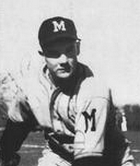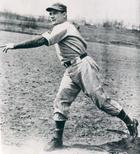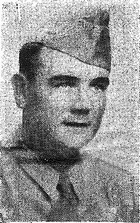Earl Springer
| Date and Place of Birth: | December 19, 1918 Hagerstown, MD |
| Date and Place of Death: | January 25, 1945 Nennig, Germany |
| Baseball Experience: | Minor League |
| Position: | Pitcher |
| Rank: | Sergeant |
| Military Unit: | Company B, 7th Armored Infantry Battalion, 8th Armored Division US Army |
| Area Served: | European Theater of Operations |
Earl V. "Lefty" Springer was one of 11 children born to Mr. and Mrs.
Harry C. Springer in Hagerstown, Maryland. He was an excellent
left-handed pitcher at Hagerstown High School, and also played with
Sharpsburg and the Hagerstown Cabbies in the local Washington County
League. In 1937, he enrolled at the University of Maryland, where he
excelled at baseball and soccer. Playing for coach H. Burton Shipley,
Springer blanked Dartmouth, 10-0, on April 7, and beat Georgetown, 4-0,
with a one-hitter to finish the season with an 8-1 record. But the
highlight of the year was his no-hitter against Rutgers on April 1,
1939. "Zipping his fireball through the murky air with electrifying
force," announced the Washington Post the following day, "and mixing
with it a hook which darted in and around enemy bats with snakelike
effect ... Earl Springer ... pitched a five inning, no-hit, no-run game
yesterday as Maryland blanked Rutgers, 3-0.
In 1940, his senior year, he beat Duke, 6-1, giving up two hits, and
hurled one-hitters against William & Mary and George Washington
University. Keeping a close eye on Springer throughout the season was
former major league infielder Fritz Maisel, who, in 1940, was a club
director with the Baltimore Orioles of the Class AA International
League. Springer pitched against the Orioles for the University of
Maryland, and on several occasions during the early part of the season
he went to Oriole Park to workout and talk to manager Tommy Thomas. "All
of our players said Springer had plenty on the ball and was tough to
hit," declared Thomas. "Pitchers, especially southpaws, with promise
aren't easy to pick up these days, but I think Earl has a real chance of
going places."
On May 27, 1940, Springer was signed by the Orioles and made 18
appearances over the season for a 1-2 record and 4.28 ERA. In 1941, he
got off to a poor start, and on June 24, the Orioles optioned the
22-year-old to his hometown Hagerstown Owls of the Class B Interstate
League. Springer helped the Owls to a second-place finish with a 5-8
record and 2.91 ERA in 14 appearances, and struck out 67 in 99 innings.
On January 15, 1942, Springer entered military service with the Army. He
trained at Fort Knox, Kentucky, with the 7th Armored Infantry Battalion,
8th Armored Division, which later moved to Camp Polk, Louisiana.
Sergeant Springer pitched a number of games for the division baseball
team at Camp Polk, where one of his teammates was Emmett "Heinie"
Mueller of the Philadelphia Phillies. In October 1944, the 8th Armored
Division left Louisiana for Camp Kilmer, New Jersey, staging camp for
troops being deployed to Europe. The division sailed on November 7, and
arrived in England on November 22. They encamped at Tidworth Barracks
and began six weeks of preparation for combat in Europe.
The division arrived in France at the beginning of 1945. In freezing
winter conditions it advanced to Pont-a-Mousson in northeast France,
arriving on January 12. After dark, on January 24, 1945, the 7th Armored
Infantry Battalion moved north to its assembly point at Besch, Germany,
in preparation for the next day's attack at Nennig. At 5:50 A.M. on
January 25, the battalion launched an attack against strong enemy
resistance. Springer was with Company B which attacked in M3
armor-plated half-track vehicles and suffered heavy casualties including
the death of the company commander, Captain Grover Hermann, and the
division's pitching ace, Sergeant Earl Springer.
Springer was buried at the Luxembourg American Cemetery, where, since
1945, local resident, Jean Folschette, has carried flowers to the grave
of the man he never knew. Folschette "adopted" Springer's grave as an
expression of gratitude to American soldiers who liberated his homeland
from the grip of the Nazis. Folschette has corresponded with the
Springer family for many years and regularly sends photos of the newly
decorated grave. He has always refused offers from the family to pay for
the flowers.
|
Year |
Team |
League |
Class |
G |
IP |
ER |
BB |
SO |
W |
L |
ERA |
| 1940 | Baltimore | International | AA | 18 | 40 | 19 | 26 | 20 | 1 | 2 | 4.28 |
| 1941 | Baltimore | International | AA | 13 | 27 | 30 | 24 | 13 | 0 | 1 | 10.00 |
| 1941 | Hagerstown | Interstate | B | 14 | 99 | 32 | 47 | 67 | 5 | 8 | 2.91 |

Earl Springer in 1942
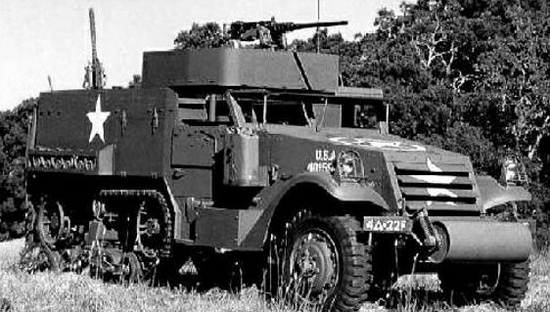
M3 Half-Track. The type in which Earl Springer lost his life in January 1945
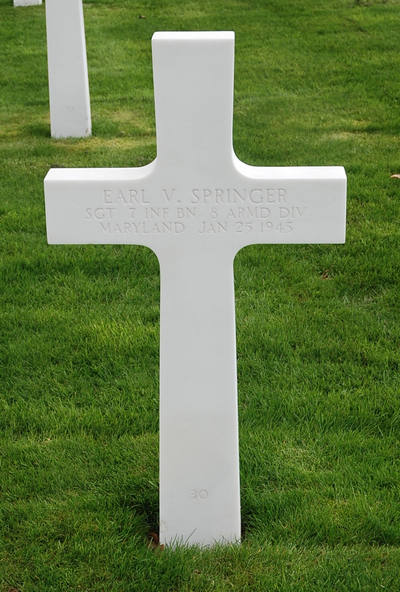
The grave of Sergeant Earl Springer
at the
Luxembourg American Cemetery in Hamm, Luxembourg
Date Added March 15, 2012 Updated June 10, 2014
Baseball's Greatest Sacrifice is associated with Baseball Almanac
Baseball's Greatest Sacrifice is proud to be sponsored by

